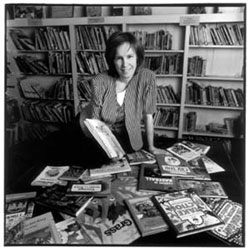Calkins on The Mayor's Library Project
"When Mayor Giuliani announced a raft of education proposals in his final state-of-the-city speech in January, one in particular seemed to assure him a solid legacy: the creation of small libraries in each of the city's 21,000 elementary and middle school classrooms," The New York Times reported recently. Work already in progress at Professor Lucy Calkins' Reading and Writing Project would become an integral part of the resulting project, now generally known as "The Mayor's Classroom Library Project."
"For me The Mayor's Classroom Library Project began," said Calkins, "when Alan Levenstein, a member of President Levine's Advisory Council and retired chairman of a publicly traded advertising company, Bozell Worldwide, came to me and said, 'I have been watching what the Teachers College Reading and Writing Project does, and I would like to give you a grant to do whatever you think would be the most important thing to lift up the level of education for New York City children.'"
Calkins immediately responded, "Let's get books into classrooms. Because in overcrowded city classrooms where kids have lots of needs-whether smaller classes or teachers who need more professional development-putting books in their hands can make a difference."
In an interview with Professor Calkins in her Horace Mann office, she added, "Books don't require new buildings to be built. Books don't require incredible professional development. Throughout history, we have heard about people who have become educated by reading books. Books can open worlds to people. In most of the classrooms I work in there is a crisis-there are no books. If there are books, they are often inappropriately chosen books for the readers who are there."
Levenstein and Calkins began dreaming about adopting some schools and creating state-of-the-art libraries in those schools. The problem was that even though Levenstein was giving the Reading and Writing Project a substantial grant, it couldn't come close to covering books for every classroom.
"So," Calkins said, "we decided to re-imagine his grant to go towards a process that might make it more possible for philanthropic people like Alan to adopt schools and create state-of-the-art libraries in those schools."
Then they began a process of thinking about what a state-of-the-art library might be like. "You might think that that is easy, but in fact, it is incredibly complicated," she said. "It means that we had to look at children in our classrooms and study them in terms of what kind of books they are able to read and what books do they love?"
They analyzed the needs of classrooms in New York City to find out what books tend to be there, which aren't there yet as well as search for the best books that they could find.
They worked with 150 teachers that were broken into small task forces that met two or three times a month for almost two years. One group took on early chapter books while another took on very early books.
"The charge of each group was to track down wise people across the city and the country, such as the Library Power Projects, journals on children's literature such as the Horn Book, and the Robin Hood Foundation," she said, "that were doing parallel work with large-scale school libraries."
In the meantime, at the request of Schools Chancellor Harold O. Levy, the Mayor made a commitment of $31.5 million in city money to put a high-quality library into every NYC classroom. That commitment made headlines and drew applause for Mr. Giuliani.
In January of 2001, Judith Rizzo, Deputy Schools Chancellor, and Peter P. Heaney, Jr., Executive Director, Division of Instructional Support, were asked for some suggestions on educational priorities.
"Peter Heaney and Judith Rizzo shared the Teachers College Reading and Writing Project's belief that we can't have standards that require children to read twenty-five books a year without provisioning all children with these books," said Calkins. "Recognizing the value of the initiative, the Mayor decided to support it, and was happy to announce 'that students in the classroom will have books around them-books that they can touch, books that they can read.'"
"Once there was a green light on this endeavor," Calkins said, "it was crucial to involve all of the stake-holders. Leaders from the UFT and from every nook and cranny of the Board of Education, and especially from the Division of Instructional Support, joined into the process of refining the libraries we'd developed."
She said that often on weekends they would be at Teachers College looking at the books and thinking about ones that they hadn't included and changing the list to make sure that it reflected everybody's interests.
It is important, Calkins said, that 40 percent of the books have a couple of pages, called write-ups, that accompany them which describe the teaching opportunities that are in the books.
These "write-ups" include a book's summary-which is not as important if it is a very short book, but for longer novels it's a great help. It includes other books the author has written and other books in the series. Also, they explain the difficulties students have encountered and the kinds of book conversations teachers might initiate.
To complete their classroom libraries, each teacher can also choose three of eight possible "modules," of 50 specialized books each, that dovetail with the core they order. This is a way to provide teachers with flexibility to match their book collections with their lesson plans. There are also Chinese and Spanish language modules developed by the Central Board Office of English Language Learners.
Calkins then looked out the window and said, "I think a good thing has been done. The Mayor and the Chancellor deserve applause."
Published Monday, May. 20, 2002
